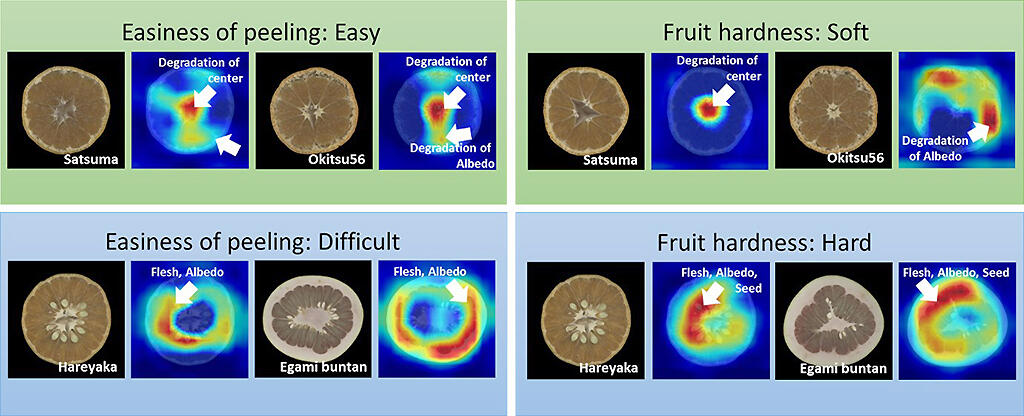A technology to quantitatively evaluate the morphological characteristics of citrus fruits from images of their cross sections has been announced. It was developed by a collaboration between post-doctoral researcher Mai Minamikawa (Japan Society for the Promotion of Science), Associate Professor Hiroyoshi Iwata (Both of The University of Tokyo Graduate School of Agricultural and Life Sciences ), Assistant Group Leader Keisuke Nonaka (Division of Citrus Research, NARO Institute of Fruit Tree and Tea Science (NIFTS)), and others. Using a combination of image analysis and AI technologies, the group clarified the morphological features strongly associated with the ease of peeling (peeling properties) and the fruit hardness of citrus fruits. This achievement is expected to lead to the efficient collection and evaluation of genetic resources and improved efficiency of genomic breeding. The described results were published in the February 10 issue of the international scientific journal Frontiers in Plant Science.

Provided by The University of Tokyo
Generally, in fruit breeding, a large number of cultivar candidates are cultivated, and their fruit characteristics are subsequently recorded and evaluated. These evaluations have traditionally been done manually by a limited number of skilled professional breeders. According to NARO, 2,000-3,000 individual citrus fruits are evaluated each year, all within a short time frame. However, the methods and effectiveness of evaluating fruit characteristics can vary greatly between breeders. It was difficult to improve the efficiency of fruit characteristic evaluation by image analysis alone.
Therefore, in this research, the research group aimed to clarify the morphological characteristics of fruits related to ease of peeling and fruit hardness by using AI technology to analyze the evaluations made by breeders. First, the group examined an automatic method to quantitatively evaluate citrus fruit morphological characteristics by analyzing cross-sectional images. They created cross-sectional images of 108 citrus varieties and lines cultivated at the NARO Citrus Research Station (Shizuoka City, Shizuoka Prefecture).
Using the programming language Python, the group developed a program which can quantitatively evaluate various fruit morphological features from images of fruit cross sections. Specifically, it can measure features like: the thickness of the rind's outer layer (flavedo) and white inner layer (albedo); the number of fruit segments; the area of the cavity between the rind and flesh (space between the albedo and segments); and the hollowness of the center (degradation of the center). Next, a machine-learning algorithm was used to compare this data to the peeling properties and fruit hardness values evaluated by breeders.
It was found that the degree of degradation of the center was strongly related to both characteristics; the fruit with highly collapsed cores tended to be soft fruit and easy to peel. On the other hand, the ratio of seed area to fruit area was only strongly related to fruit harness; fruits with a large seed: fruit ratio tended to be harder. Analysis of this causal relationship using a Bayesian network showed that the degree of central core degradation directly affects both properties - the ease of peeling and firmness, whereas seed area may directly affect the firmness of the fruit. Furthermore, using deep learning, the group developed a model that can distinguish whether fruit is easy or hard to peel, and whether it is soft or hard, from cross-sectional images. Additionally, they visualized the features that contributed to these classifications. Then, analysis of the characteristics of the central core and albedo contributed to the classification of hard fruits that are easy to peel. It was found that the characteristics of the seed area contributed only to the classification of hard fruits.
The hardness and ease of peeling predictions made using this method were almost as accurate as breeder evaluations. By improving the degree of collapse of the central core and the seed area, there is a possibility that new varieties with desirable peeling properties and fruit firmness can be developed. In addition, using this method will enable the automatic generation of large amounts of data on the morphological characteristics of fruits related to peeling and fruit hardness, which is expected to improve the efficiency of breeding. According to Post-Doctoral Researcher Minamikawa, "It can be applied not only to citrus fruits but also to various other fruit species. If we can automatically acquire a range of phenotypic and morphological characteristic data of fruits, we expect that breeding that efficiently utilizes genomic information will be promoted across all fruit cultivation methods."
This article has been translated by JST with permission from The Science News Ltd.(https://sci-news.co.jp/). Unauthorized reproduction of the article and photographs is prohibited.




